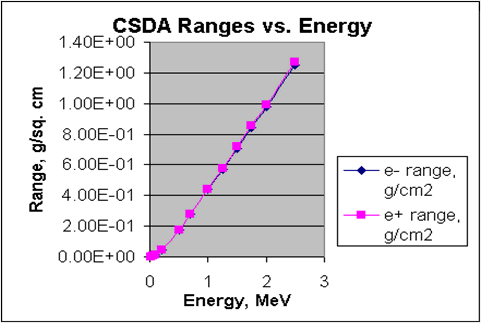Answer to Question #6240 Submitted to "Ask the Experts"
Category: Radiation Basics — Beta Particles (negative and positive) and Electrons
The following question was answered by an expert in the appropriate field:
I would like to see plots of positron range vs. energy for energies <2 MeV compared with electrons of the same energy. Basically, I want to know how far a positron of a given energy will travel before annihilation, if possible, for various materials.
A good source for range data for electrons and positrons is ICRU Report 37, Stopping Powers for Electrons and Positrons, International Commission on Radiation Units and Measurements, 1984.
The ranges given in the report are what are referred to as CSDA ranges, usually expressed in mass density thickness units—for example, g cm-2; CSDA is an acronym for continuous slowing down approximation and refers to the process whereby the charged particle of interest is assumed to lose energy in a continuous and smooth fashion such that the range of the particle, as it slows from initial energy T0 to final energy Tf, can be obtained by an integration of the inverse stopping power functions, as done in ICRU Report 37:

where ρ is the material density, Scol(T) is the linear collision stopping power at energy T, and Srad(T) is the radiative stopping at energy T. (The expression for the range is also corrected to allow an approximation when particle energy gets down to about 1 keV.)
The mathematical expressions used for collision stopping powers for electrons and positrons are very similar but differ in one term that produces most notable differences when large energy transfers are possible. This is affected by the fact that it is possible for a positron to lose all of its energy in a single interaction, while an electron can lose no more than half of its energy. Because positrons experience a repulsive force in the vicinity of the nucleus and electrons experience an attractive force, the cross sections for radiative (bremsstrahlung) losses also differ for the two particles; the differences are most significant at low energies where the bremsstrahlung cross sections are considerably smaller for positrons than for electrons.
The end result on calculated ranges, considering both collision and radiative differences in energy losses, is that for a given material, the CSDA range is typically somewhat smaller for positrons than for electrons up to energies between 0.5 MeV and 1 MeV, and at higher energies the positron ranges are somewhat greater than the electron ranges.
Below I have extracted data from ICRU Report 37 and plotted points for ranges of electrons and positrons in water. You can see slight differences in values in the tabular data, but the separation in the plotted data are not easily discernible. Similar behavior is observed for other materials, although the absolute values of the CSDA ranges of materials have a rather strong dependence on atomic number of the material of interest, with CSDA ranges (in density thickness units) increasing with increasing atomic number. For example, the CSDA range of a 2 MeV positron in lead is 1.762 g cm-2, compared to 0.995 g cm-2 in water.
| Energy, MeV | e- range, g cm-2 | e+ range, g cm-2 |
|---|---|---|
| 0.01 | 2.52 x 10-4 | 2.25 x 10-4 |
| 0.025 | 1.28 x 10-3 | 1.17 x 10-4 |
| 0.05 | 4.32 x 10-3 | 4.02 x 10-34 |
| 0.1 | 1.43 x 10-2 | 1.36 x 10-2 |
| 0.2 | 4.49 x 10-2 | 4.34 x 10-2 |
| 0.5 | 1.77 x 10-1 | 1.75 x 10-1 |
| 0.7 | 2.78 x 10-1 | 2.78 x 10-1 |
| 1 | 4.38 x 10-1 | 4.40 x 10-1 |
| 1.25 | 5.73 x 10-1 | 5.78 x 10-1 |
| 1.5 | 7.09 x 10-1 | 7.17 x 10-14 |
| 1.75 | 8.45 x 10-1 | 8.56 x 10-1 |
| 2 | 9.80 x 10-1 | 9.95 x 10-1 |
| 2.5 | 1.25 x 100 | 1.27 x 100 |

Specifically regarding annihilation of positrons that you mention, we should note that while the CSDA range provides a good indication of how far a positron will travel before expending its excess kinetic energy, whereupon it will annihilate with a conventional electron, some positrons do annihilate in flight before getting to the end of their ranges. This means that a positron with some excess kinetic energy may encounter an electron and annihilate, whereupon both the rest masses of the electron and positron as well as the excess kinetic energy that the positron had go into the energies of the annihilation photons. Thus, the annihilation photons, in this case, may have energies higher than the 0.511 MeV observed for annihilation at rest. In-flight annihilation does not occur frequently for positron energies of usual interest; it has been estimated that the positron loses about the same fraction of its energy through in-flight annihilation as it does through bremsstrahlung energy losses.
I hope this is helpful. I do suggest the cited ICRU reference if you need specific information for other materials. You can also find a variety of information on the Internet by searching "positron stopping powers and ranges" and doing similarly for electrons.
George Chabot, PhD, CHP


